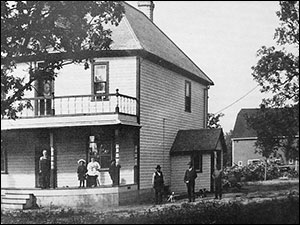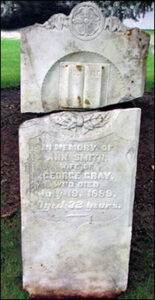Gray Family Farm
25-6-6w
Five generations of the Gray family have lived on 25-6-6w. What is distinctive about the farm is that they share this section of land with Graysville, the community that bears their name. Another unique feature of the farm is that the original homestead claim was made in the name of Ann Smith Gray, under the Métis land claim agreement.
This sets the Gray farm apart from other homesteads in the area which were obtained through homestead claims, military scrip, or by direct purchase from companies such as the HBC or from land speculators (see Recent History January, 2019) .
George Gray Sr., great-grandfather of the present landowner, came to the Red River settlement from Aberdeen, Scotland in 1872. He worked for four years in John Taylor’s store in Headingley before marrying Ann Smith and moving to the Boyne district.
Ann Smith’s family had deep roots in the Hudson Bay Co. territory. Her father, William Robert Smith, came to York Factory from Surrey, England in 1813 to work for the HBC. He served with the company until 1824, then became a teacher at the Red River Settlement. In 1852, he was appointed clerk to the Council of Assiniboia. Ann’s mother, Ann Omand Smith, had Métis status through her mother Jane Brown. Under the Dominion Land Act of 1872, both Ann Omand Smith and her daughter Ann, as Métis residents of the former HBC territory, were awarded scrip entitling them to lay claim to 160 acres of land.

Gray Home built 1916
Ann Smith laid homestead claim to the SE ¼ of 25-6-6w near the Boyne River in 1874, prior to her marriage to George Gray. She was awarded patent to that land and the adjoining NE ¼ section in 1881. George Gray purchased the west half of the section in 1881. The family first built a log home on the SE ¼, replacing it in 1916 with a larger house (below) in which future generations of the Gray family were born.

Ann Smith headstone
George and Ann (Smith) Gray had twins who died shortly after birth; they were buried in the now-abandoned Harrison burial site near their farm. The Grays had three more children: two daughters, Georgina and Agnes, and a son James. The girls stayed with an aunt in Headingley to attend school until Orr School opened.
Ann died at the age of 32 and was buried in the Harrison burial site. Her broken headstone was retrieved from the site and is a prized possession of the current George Gray family.
When the Canadian Northern Railway built a line west from Carman through the Gray property, George Sr., known as “Boss”, recognized the opportunity and built a store at the site that became Graysville. The first school was built in 1909 on Gray land, just north of the railway. That building was sold in 1934 and moved south of the rail line where it was used as a dwelling, store, and post office. George Gray also donated the land on which the Graysville United Church and other buildings were built.
The Gray property has been handed down through the generations from George Sr. to son James, to his son Hector. It currently is owned by Hector’s son, George, and his wife Noreen. They moved the 1916 house across the farmyard and joined it to their bungalow. The house has been renovated but retains many of its original features. George and Noreen have five children.
George has served as Councillor for the RM of Dufferin and is currently serving his second term as Reeve of the Municipality. In keeping with his rich family history, George is known for his keen interest in local heritage.
See also:
History of the RM of Dufferin in Manitoba, 1880-1980, pp. 43-44 for more information on Graysville, and pp. 496-490 for photos of the Gray family and property.
Carman-Dufferin Cemeteries – A guide to the history, location, art and craft of local cemeteries, p.108 for photo and details of Ann Gray’s burial site and grave marker.
CDMHAC Blog, October 2016, for a 1908 ad from the George Gray store in Graysville.
